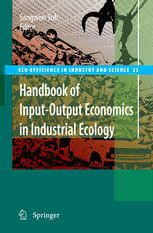Table Of ContentHandbook of Input-Output Economics
in Industrial Ecology
ECO-EFFICIENCY IN INDUSTRY AND SCIENCE
VOLUME23
SeriesEditor:ArnoldTukker,TNO,Delft,TheNetherlands
EditorialAdvisoryBoard:
Martin Charter, Centre for Sustainable Design, The Surrey Institute of Art & Design,
Farnham,UnitedKingdom
JohnEhrenfeld,InternationalSocietyforIndustrialEcology,NewHaven,U.S.A.
GjaltHuppes,CentreofEnvironmentalScience,LeidenUniversity,Leiden,TheNetherlands
Reid Lifset, Yale University School of Forestry and Environmental Studies, New Haven,
U.S.A.
TheodeBruijn,CenterforCleanTechnologyandEnvironmentalPolicy(CSTM),University
ofTwente,Enschede,TheNetherlands
Forothertitlespublishedinthisseries,goto
www.springer.com/series/5887
Handbook of Input-Output
Economics in Industrial
Ecology
Edited by
Sangwon Suh
UniversityofMinnesota
123
Editor
SangwonSuh
UniversityofMinnesota
DepartmentofBioproductsandBiosystemsEngineering
1390EcklesAvenue
SaintPaul,MN55108-6005
U.S.A.
ISSN1389-6970
ISBN978-1-4020-4083-2 e-ISBN978-1-4020-5737-3
DOI10.1007/978-1-4020-5737-3
SpringerDordrechtHeidelbergLondonNewYork
LibraryofCongressControlNumber:2009926506
(cid:2)cSpringerScience+BusinessMediaB.V.2009
Nopartofthisworkmaybereproduced,storedinaretrievalsystem,ortransmittedinanyformorby
anymeans,electronic,mechanical,photocopying,microfilming,recordingorotherwise,withoutwritten
permissionfromthePublisher,withtheexceptionofanymaterialsuppliedspecificallyforthepurpose
ofbeingenteredandexecutedonacomputersystem,forexclusiveusebythepurchaserofthework.
CoverphotographybyJaeK.ChoiandSangwonSuh
Printedonacid-freepaper
SpringerispartofSpringerScience+BusinessMedia(www.springer.com)
Preface
From the early 2000s, the members of the Society for Environmental Toxicology
andChemistry(SETAC)-Europenoticedthattheywerehearingmoreoftenduring
theirannualmeetingsaboutsomethingcalledinput-outputeconomics.TheSETAC-
EuropehadbeenthecradleofLifeCycleAssessment(LCA)methodology,andits
members were mainly engineers and natural scientists. For many of them, input-
output economics was an area that was greatly interesting and equally foreign.
About the same time, the members of the International Input-Output Association
(IIOA)couldnotmissthatasubstantialnumberofthepresentationsoftheirbian-
nualmeetingswerethemedaroundtheenvironmentandsustainability.Thiswasthe
timewhennewsessionsonLCAandIndustrialEcologystartedtobeorganizeddur-
ingIIOAmeetings.ItwasalsothetimethattheInternationalSocietyforIndustrial
Ecology(ISIE)tookoff,providingahomeformanywhowereworkingbetweenthe
interfacesoftraditionaldisciplines.
In the course of these meetings, it became clear that LCA researchers, input-
output economists, and industrial ecologists had a lot to learn and benefit from
each other. At the same time, it was also clear that there were disciplinary barri-
ershamperingeffectivecommunicationamongthesegroups.Acommonlanguage
andplatformforcommunicationwasinneedamongthesegroupstomaterializethe
benefits.
Recognizing these needs, the LCA steering committee of SETAC-Europe, then
chairedbyAngelinedeBeaufort,approvedanewSETAC-EuropeWorkingGroup
(WG)onInput-OutputAnalysis(IOA)in2003,forwhichIservedasachairfor3
years.ThefirstmeetingoftheWGanditsfirstworkshopwasheldonMay1,2003in
Hamburg,GermanyinvolvingaroundadozenSETAC-Europemembers.Itbecame
evident during thefirstmeeting thatthe WGshouldreach outtoother societies to
embracebroaderexpertiseinandaroundinput-outputeconomics.TheISIEandits
executive director, John Ehrenfeld, recognized the WG and approved the second
workshoptobeheldinconjunctionwithitsbiannualconferenceonJuly2,2003in
AnnArbor,MI,USA,whereover70participantsweregathered.TheWGcontinued
tomeetinPrague,CzechRepublicandinStockholm,Sweden,whichservedasan
importantinternationalplatformforexchangingknowledgeandexperienceamong
researchersfromvariousbackgrounds.
v
vi Preface
Thishandbookisaresultofthemultipleyearsofeffortsrootedfromthesenumer-
ousworkshopsandmeetings.Itcontainscontributionsfromaround70authorsfrom
19countries embracing thestate-of-the-arttheoryand principlesaswellaspracti-
calapplicationsofinput-outputeconomicsforansweringthequestionsinindustrial
ecology.Thegroupofauthorswithinthishandbookrepresentsawidespectrumof
expertisefromacademia,nationallaboratories,statisticaloffices,andresearchinsti-
tutes,andcontributorsincludethescholarsholdingeditorialresponsibilitiesofkey
journals of the field, such as the Journal of Industrial Ecology, Economic System
Research, and International Journal of Life Cycle Assessment, as well as the past
andthecurrentleadersofvariousprofessionalsocieties.
The handbook covers an array of topics including the history of industrial
ecologyandinput-outputeconomics,materialflowanalysis,LCA,sustainablecon-
sumption, policy applications, energy and climate change, waste management,
national accounts and statistics, and new developments in modeling and theory.
Particularly,thishandbookisdesignedtoofferacomprehensivecoverageonthree
major issues: (1) theory and method of key analytical tools and models; (2) fun-
damental accounting principles and compilation of basic data; and (3) practical
applicationsofthetoolsandmodelsatvariousscales.First,variousanalyticaltools
and modeling techniques that are of particular importance to industrial ecology
applications are comprehensively treated in this handbook, which includes hybrid
modelsforLCA,MaterialFlowAnalysis(MFA)andenergyanalysis;physicaland
hybrid-unit IO models; Waste IO model; multi-regional IO models; dynamic IO
model;thermodynamicanalysis;linearprogrammingandoptimizationtechniques;
graphtheoryandnetworkanalysis;useofscenarios;andStructuralDecomposition
Analysis(SDA).Second,basicaccountingframeworksandcompilationofrequired
datafortheseanalyticaltoolsandmodelsareshown,whichcoverse.g.,thesupply-
use framework, resources accounts, time-use survey, Social Accounting Matrices
(SAMs),compilationofenvironmentalIOdatabasesofJapan(3EID)andtheU.S.
(CEDA). Third, use of these data, tools and models for micro-, meso-, as well as
macro-scale applications are presented throughout the chapters. Readers will also
notice the difference in mode of writing in some chapters: for instance, some are
writtenmoreasapracticalandinstructiveguide(e.g.,thestep-by-stepapproaches
for net energy analysis of Chapter 24) and some are done more as a theoretical
contribution(e.g.,themultistageprocess-basedmake-usesystemofChapter35).
Eachofthe38chaptersofthishandbookisself-contained,whilesomechapters
provide boxes to explain some of the basics, which can be referenced across the
chapters.Theboxeslike“GeneralaccountingstructureofaPhysicalInput-Output
Table” (Chapter 4) and “Taxes in Input-Output Tables” (Chapter 18) are good ex-
amples. Balancing geographical and disciplinary coverage with the depth of the
contributionswasanimportantconsiderationindesigningthehandbookaswell,so
that it can serve a wide range of audiences with different knowledge levels, disci-
plinarybackgroundsandgeographicallocations.Asaconsequence,somechapters
mayservetheneedsofaparticulargroupofaudiencesbetterthanothers.
This handbook could not have been produced without the help and support of
many. I thank Angeline de Beaufort, John Ehrenfeld, and Faye Duchin for their
Preface vii
generoussupportstothisinitiative.IthankthemembersoftheSETAC-EuropeLCA
steeringcommittee,andthecouncilsoftheISIEandIIOAfortheirsupportinorga-
nizing some of the early meetings. I thank Helias Udo de Haes, Gjalt Huppes and
my colleagues at the Institute of Environmental Sciences (CML) for their encour-
agementandsupportduringtheearlystageoftheinitiative.IthankScottMatthews,
Chris Hendrickson and other colleagues at the Department of Civil and Environ-
mental Engineering at Carnegie Mellon University (CMU) for their support while
IwasworkingatCMU.IthankShriRamaswamyattheDepartmentofBioproducts
andBiosystemsEngineeringoftheUniversityofMinnesota(UMN)forhissupport
tothiswork.Inthecourseofitsevolution,thishandbookhasbeeninthehandsof
four publisher-editors: Henny A.M.P Hoogervorst, Esther Verdries, Fabio de Cas-
tro, and Fritz Schmuhl. I thank all of them for their patience and excellence. I am
gratefultotheserieseditor,ArnoldTukkerforhisvaluableadvices.Theassistants
fromthemembersoftheIndustrialEcologyLabattheUniversityofMinnesotawere
invaluable. I thank Junghan Bae, Ryan Barker, Yiwen Chiu, Amber Illies, Jinseon
Park,BrianRamackel,KyoSuh,BrianWalseth,andYangYifortheirhelp.Last,but
notleast,Ithankalltheauthorsfortheirvaluablecontributions,patienceandfaith.
Forsomechapters,therewerearealeaderswhogreatlyhelpedstructurethishand-
book and facilitate peer-reviews. I thank area leaders Susanne Kytzia (PART II),
AnnemarthIdenburg(PARTV),ManfredLenzen(PARTVI),ShinichiroNakamura
(PARTVII),andReidBailey(PARTIX)fortheirleadership.
Havinggonethroughalongjourney,thisvolumecamenotwithoutregrets.Keep-
ingtrackofalargenumberofmanuscripts,peer-reviews,andrevisionswasnotan
easy task, and given the large number of authors involved, human factors should
have been better incorporated in planning and scheduling each step. At the begin-
ning, it was the intention to assign each alphabet to note a particular matrix in
input-output economics, like V for supply matrix, for instance, and use it consis-
tently throughout the handbook. After spending quite some time juggling around
thelettersoverseveralchapters,Irealizedthatthereareonly26lettersinthealpha-
bet, while innovativeness of the authors knows no limit.While this handbook was
beingshaped,mycareerhadtospanoverthreeinstitutesacrosstheAtlantic,andat
timesotherdutiesandcommitmentsinterruptedtheeditingprocess,sometimesfor
anextendedperiod.Iwouldliketooffermysincereapologiesforthosewhohave
beenawaitingthishandbookforalongtime.
Iwishthatthishandbookservesasaone-stopreferencebookforbothindustrial
ecologistsandinput-outputeconomistswhoareexploringtheotherdiscipline.Ibe-
lievethatthishandbookisausefulguidancealsoforthosewhostudyLCA,energy
andclimatechangepolicy,environmentalproductpolicyandsustainableconsump-
tion.Iwishthatthereadersfindthishandbookavaluablecompanionintheirjourney
acrossdisciplines.
October2008,Twincities S.Suh
Contents
Preface............................................................................. v
Contributors...................................................................... xv
ListofFigures .................................................................... xxi
ListofTables......................................................................xxvii
ListofBoxes ......................................................................xxxv
PartI Introduction
1 IndustrialEcologyintheAgeofInput-OutputAnalysis................ 3
ReidLifset
2 Input-OutputEconomicsandMaterialFlows............................ 23
FayeDuchin
3 IndustrialEcologyandInput-OutputEconomics:ABrief
History........................................................................ 43
SangwonSuhandShigemiKagawa
PartII MaterialFlowAnalysis
4 Conceptual Foundations and Applications of Physical
Input-OutputTables ........................................................ 61
StefanGiljumandKlausHubacek
5 ModellingManufactured CapitalStocksandMaterial
FlowsintheAustralianStocksandFlowsFramework.................. 77
JamesA.LennoxandGrahamM.Turner
ix
x Contents
6 AnInput-OutputFrameworktoEnhanceConsistency
inHybridModeling ......................................................... 99
SusanneKytzia
7 PhysicalInput-OutputAnalysisandDisposalstoNature............... 123
Erik Dietzenbacher, Stefan Giljum, Klaus Hubacek,
andSangwonSuh
8 AccountingandModellingGlobalResourceUse ........................ 139
Stefan Giljum, Friedrich Hinterberger, Christian Lutz,
andBerndMeyer
9 ConstructingPhysicalInput-OutputTableswithMaterial
FlowAnalysis(MFA)Data:Bottom-UpCaseStudies................... 161
OttiliaDeMarco,GiovanniLagioia,VeraAmicarelli,
andAntonellaSgaramella
10 AnalysingtheEconomicImpactsofaMaterialEfficiency
Strategy....................................................................... 189
CarstenNathani
PartIII LifeCycleAssessment
11 AComparisonBetweenConventionalLCAandHybrid
EIO-LCA: Analyzing Crystal Giftware Contribution
toGlobalWarmingPotential............................................... 219
PauloFerra˜oandJorgeNhambiu
12 ApplicationoftheSequentialInterindustryModel(SIM)
toLifeCycleAssessment.................................................... 231
StephenH.Levine,ThomasP.Gloria,andEliahuRomanoff
13 Life-Cycle Assessment (LCA) as a Management Tool:
AnEmphasisonElectricityGeneration,GlobalClimate
Change,andSustainability................................................. 247
SergioPacca
14 MethodsintheLifeCycleInventoryofaProduct....................... 263
SangwonSuhandGjaltHuppes
PartIV SustainableConsumption
15 Principal Methodological Approaches to Studying
SustainableConsumption:ScenarioAnalysis,Ecological
FootprintsandStructuralDecompositionAnalysis ..................... 285
RichardWoodandManfredLenzen

